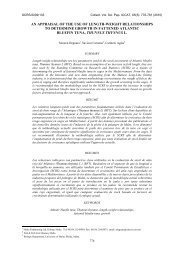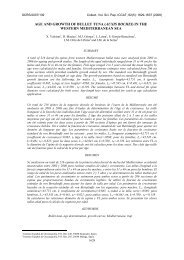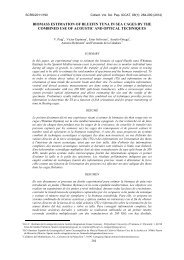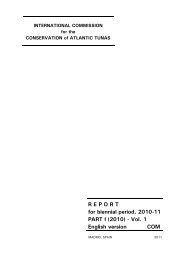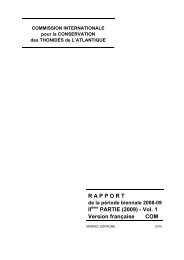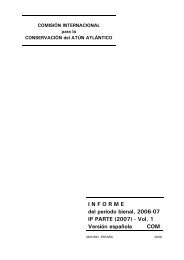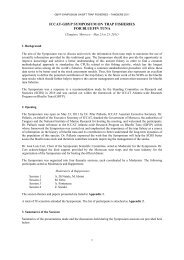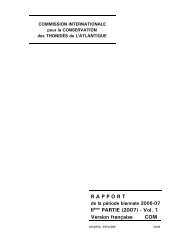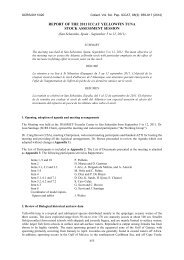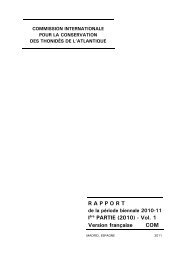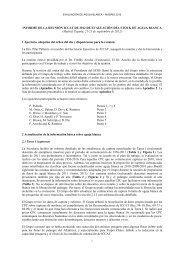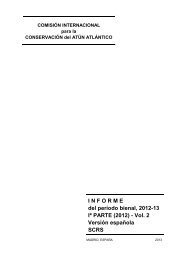E - Iccat
E - Iccat
E - Iccat
You also want an ePaper? Increase the reach of your titles
YUMPU automatically turns print PDFs into web optimized ePapers that Google loves.
PANEL 1 REPORT<br />
ANNEX 8<br />
REPORTS OF THE MEETINGS OF PANELS 1-4<br />
REPORT OF THE MEETING OF PANEL 1<br />
1. Opening of the meeting<br />
The Panel was chaired by Dr. Abdellah Srour (Morocco). In the interest of time, it was requested that opening<br />
statements be submitted in writing; no opening statements were submitted to Panel 1.<br />
2. Adoption of Agenda<br />
The Agenda was adopted as proposed (Appendix 1 to ANNEX 8).<br />
3. Appointment of Rapporteur<br />
Mr. Bryan Wood (Canada) was appointed Rapporteur of Panel 1.<br />
4. Review of Panel Membership<br />
Panel 1 is comprised of 24 Contracting Parties: Angola, Brazil, Canada, Cape Verde, China, Côte d’Ivoire,<br />
European Community, Gabon, Ghana, Honduras, Japan, Korea (Rep.), Libya, Mexico, Morocco, Namibia,<br />
Panama, Russia, Sao Tomé and Principe, South Africa, Trinidad and Tobago, United Kingdom (Overseas<br />
Territories), United States, and Venezuela. The Chairman welcomed South Africa as a new member of Panel 1.<br />
Cape Verde, Honduras, Libya, Panama, Sao Tomé and Principe and Venezuela were not present at this meeting.<br />
5. Report of the Standing Committee on Research and Statistics (SCRS)<br />
5.1 Yellowfin tuna<br />
Dr. Joao Gil Pereira, Chairman of the SCRS, presented the results of the stock assessment conducted for<br />
yellowfin tuna in 2003. He noted that it included data only up to 2001 as less than 20% of the 2002 data were<br />
available at the time the assessment was carried out. He also indicated that catches of juvenile fish (0+1)<br />
appeared to be very high. Various models were applied to the available data. The equilibrium production models<br />
resulted in estimates of biomass that would support an MSY ranging from 151,300 to 161,300 t, whereas values<br />
from the non-equilibrium models ranged from 147,200 to 148,300 t. The results from the virtual population<br />
analysis (VPA) were more comparable to the results from production models than in previous years. The VPA<br />
also suggested that fishing mortality and spawning biomass were close to levels that would support MSY.<br />
Reported landings for 2001 suggested catches could be slightly higher than MSY based on certain assumptions<br />
and that recent fishing mortality also appeared to be slightly above MSY. It is important that fishing effort does<br />
not increase beyond current levels. A reduction in fishing mortality for fish less than 3.2 kg could lead to<br />
substantial gains in yield per recruit and modest gains in spawning biomass per recruit.<br />
The SCRS Chairman added that conventional assessment models were used for yellowfin and that the<br />
assessment for this species is robust.<br />
5.2 Bigeye tuna<br />
Assessment results were based on analyses conducted in 2002. The SCRS Chairman noted that the assessment<br />
process had been hampered by a lack of basic information, hence the establishment of the Bigeye Tuna Year<br />
Program (BETYP). There appeared to be a decline in longline and IUU catches. It was estimated that unreported<br />
catches are now less than 3,000 t, which represents a 90% decrease from a high of 25,000 t in 1998. However, it<br />
is not clear whether IUU vessels have indeed curtailed their catches or if they are shipping their catches<br />
177



